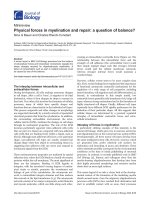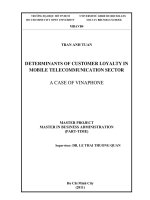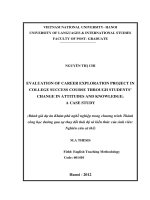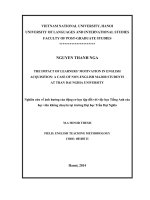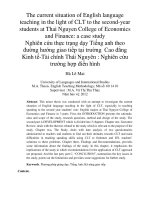Compliment speech act in english and vietnamese a case of vietnamese speakers of english
Bạn đang xem bản rút gọn của tài liệu. Xem và tải ngay bản đầy đủ của tài liệu tại đây (581.86 KB, 46 trang )
HA TINH UNIVERSITY
FACULTY OF FOREIGN LANGUAGES
NGUYỄN THỊ THU TRANG
(11131302022)
GRADUATION MINOR THESIS
COMPLIMENT SPEECH ACT
IN ENGLISH AND VIETNAMESE:
A CASE OF VIETNAMESE SPEAKERS OF ENGLISH
Ha Tinh, 2017
HA TINH UNIVERSITY
FACULTY OF FOREIGN LANGUAGES
COMPLIMENT SPEECH ACT
IN ENGLISH AND VIETNAMESE:
A CASE OF VIETNAMESE SPEAKERS OF ENGLISH
SUPERVISOR
: MA. Hoang Thi Hoan
PARTICIPANT RESEARCHER : Nguyen Thi Thu Trang
CLASS
: K6 English Language
PARTICIPANT NUMBER
: 11131302022
Ha Tinh, 2017
ii
Table of contents
Acknowledgement............................................................................................. v
Abstract ............................................................................................................ vi
Chapter one: INTRODUCTION ....................................................................... 1
1.1. Rationale of the study................................................................................. 1
1.2. Research purposes ...................................................................................... 2
1.3. Research questions ..................................................................................... 2
1.4. Contributions of the research ..................................................................... 2
1.5. Thesis Outline ............................................................................................ 3
Chapter two: DEVELOPMENT ....................................................................... 4
2.1. Literature review ........................................................................................ 4
2.1.1. Definition of compliments ...................................................................... 4
2.1.2. Functions of compliments ....................................................................... 5
2.1.3. How people pay a compliment................................................................ 7
2.1.4. Compliments and politeness ................................................................. 10
2.2. Methodology ............................................................................................ 13
2.2.1. Participants ............................................................................................ 13
2.2.2. Data collection ...................................................................................... 13
2.2.3. Data analysis ......................................................................................... 14
2.2.4. Ethical issues ......................................................................................... 14
2.3. Findings and discussion ........................................................................... 14
3.3.1. The age and compliments ..................................................................... 15
3.3.2. The gender and compliments ................................................................ 18
3.3.3. The social distance and compliments.................................................... 23
3.3.4. The closeness and compliments ............................................................ 23
3.3.5. Functions of compliments ..................................................................... 27
3.3.6. Linguistic characteristics of compliments ............................................ 31
iii
Chapter three: CONCLUSION ....................................................................... 34
3.1. Summary of the study .............................................................................. 34
3.2. Implications .............................................................................................. 35
3.3. Suggestions for further research .............................................................. 35
References ....................................................................................................... 36
Appendix ......................................................................................................... 36
iv
ACKNOWLEDGEMENT
The completion of this undertaking could not have been possible without
the participations and assistance of so many people whose names may not be
enumerated. Their contributions are sincerely appreciated and gratefully
acknowledged.
To all teachers, relatives, friends and others who in one way or another
shared their support, either morally, financially and physically, thank you.
Above all, I would like to express my deep appreciation and
indebtedness to Mrs. Hoang Thi Hoan who helped me to accomplish this
study. Her exemplary guidance, constant encouragement, and careful
monitoring throughout the internship are so great that, even my most
profound gratitude is not enough.
Thank you so much.
Nguyễn Thị Thu Trang
v
ABSTRACT:
The compliment is an expression of respect, approval and admiration,
used to congratulate, encourage or praise and make the addressee feel good.
The compliment can be described of a positive politeness strategy as it shows
the speaker’s notice and respect to the hearer’s interests, wants and “goods”.
We carried out a survey with the participation of 18 female participants at the
Faculty of Foreign Languages, Ha Tinh University. The data were collected
from questionnaires, interviews and DCT method. English and Vietnamese
belong to two different types of languages. Each language has the different
social and cultural contexts which might lead to distinctions in
communicating in general, and paying compliments in particular. Therefore,
we decided to research the compliment behaviors in English and Vietnamese
by Vietnamese speakers of English in order to investigate differences of
participants’ compliment behaviors in English and Vietnamese, then may
provide several suggestions to solve restrictions in complimenting by Ha Tinh
students.
Key words: Compliment, Vietnamese speakers, influences, functions
vi
Chapter one: INTRODUCTION
1.1. Rationale of the study
Communicating is not only the process of giving and receiving the
information, it also expresses the attitudes to the hearer. Language reflects the
social interaction between partners and what we say is determined by various
factors, such as the social distance. Actually, we do not exchange similar
words with different people in different situations and should appropriately
communicate with different addressees.
The compliment speech act occurs popularly in daily conversations, and
it is important and necessary to give suitable comments on the others. In
general, the compliment is an expression of esteem, respect, and admiration,
especially an admiring remark; congratulating, encouraging or praising
someone for something and compliments are used to make the addressee feel
good about himself/herself. The compliment speech acts could be considered
as a kind of politeness strategies. By paying compliments, the speaker shows
that she/he notices, in contrast, she/he might threaten to the partner‟s face by
ignoring them. In communications, it is important to show polite behaviors
toward others, and the awareness of your partner‟s face. When a person says
something that represents a threat to another‟s self-image, it serves as a face
threatening act. On the contrary, if you try to respect the “face wants” of the
partner, that will be called a face saving act.
English and Vietnamese belong to two different types of languages.
Each language has the different social and cultural context which might lead
to distinctions in communicating in general, and paying compliments in
particular. Therefore, we decided to research the compliment behaviors in
1
English and Vietnamese by Vietnamese speakers of English. Compliments is
a large field to study, there are a variety of aspects in complimenting, such
as giving and receiving compliments, however, we just concentrate on how
Ha Tinh participants pay compliments in a foreign language, English, and in
their mother tongue, Vietnamese. In this study, all what I presented surely
has many shortcomings due to lack of experience, limitation of time and
knowledge. Nonetheless, I hope that, to some extent, this study will help
participants have a more comprehensive viewpoint on the compliment
speech act.
1.2. Research purposes
The aim of this study is to investigate the complimenting behavior of a
group of Vietnamese participants of English in English and Vietnamese. In
the study, we would like to find out how a group of English-major
participants pay compliments in English and Vietnamese, what functions the
participants pay compliments for in English and Vietnamese.
1.3. Research questions
The research was carried out to solve these questions:
1. How does the group of Vietnamese speakers of English pay
compliments in Vietnamese and English in different settings?
2. What functions do the participants pay compliments for in English
and Vietnamese?
1.4. Contributions of the research
- In terms of science: providing a new viewpoint on compliment in
English and Vietnamese as well.
2
- In terms of reality: providing the methods to help Ha Tinh students pay
a compliment appropriately, raising the perception in complimenting.
1.5. Thesis Outline
After reading and finding out the document related to the topic of this
study, it is summarized as well as designed in 3 parts:
Chapter One: “Introduction” of the thesis, including parts: rationale,
research purposes, research questions, contributions and design of the study.
This part mainly shows the basic theories and contents related to the topic that
we are researching to help readers understand comprehensively about the
situation on topic.
Chapter Two: “Development” includes three parts:
2.1. “Literature review” mentions to theoretical background which are
introduced in definitions, functions of compliments, and how people in other
cultures pay a compliment, and the relation between compliments and
politeness.
2.2.“Methodology” presents the methodology conducted in this study; at
the same time, this chapter will deal with collecting and analyzing data from
the questionnaire system.
2.3.“Findings and discussion” shows responses from sources, and
analyze them in order to find the factors which influence on the compliment
speech act, the differences in compliment behaviors in English and
Vietnamese and the politeness in compliments.
Chapter Three: “Conclusion” summarizes the key issues in the study,
points out the limitations and gives some suggestions for further studies.
3
Chapter two: DEVELOPMENT
2.1. Literature review
2.1.1. Definition of compliments
The compliment is one of the most popular topics in linguistics. Holmes
(1986) defined the compliment as “a speech act which explicitly or implicitly
attributes credit to someone other than the speaker, regularly the person
addressed, for some good (possession, characteristic, skill, etc.) which is
positively valued by the speaker and the hearer” (p.485). Newton and
Burgoon (1990) believed that compliments are “statements that are intended
to make the other feel good about himself/herself” (p.509), as KerbratOrecchioni (1987) supposed that they are “verbal presents” (p.10).
Kodama (1996) concurred with Wierzbicka‟s statement (1987) that
compliments are an intricate combination of positive evaluation, displayed
good feelings, implicit friendliness, and half-admitted desire to please. When
one pays a compliment, in some cases, she or he covertly underestimates
herself/himself than the addressee, wishes for having the value which is
mentioned. Hence, the compliment could be the face-saving act or the facethreatening act, so that the speaker should investigate the person addressed
well and use the compliment appropriately. Compliments, according to
Jaworki (1995), can be described as “both direct and indirect utterances
expressing the speaker‟s positive opinion about the addressee‟s outward
appearance, work, personality traits, possessed, and about the third parties
closely related to the addressee (e.g. Children)” (p.64).
(1) That‟s so amazing, John. (direct)
(2) Linda said you‟ve just completed an amazing project. (indirect)
4
In Vietnam, there are just a few studies in the compliment speech act;
Quang‟s study (1999) is one of the significant projects. Other Vietnamese
linguistics, Khúc (2006) and Trần (2001) are also in agreement with his
opinion that compliments are the positive evaluation for the addressee that the
speaker highly appreciates. According to the Vietnamese Dictionary by New
Era (2005), compliments are verbal expression to praise the beauty or the
qualities of the addressee, people or things. People can give compliments
verbally, a word (usually an adjective), a sentence or a variety of sentences (a
paragraph); or compliment by gestures/body language, such as a smile, a
wink, and a big round of applause, however, in this study, we just mention to
the participants‟ verbal compliments. Generally, a compliment means that you
are contributing a valued “good” to the addressee, make him/her feel good.
2.1.2. Functions of compliments
Linguistics have studied a variety of angles of compliment and found its
different functions in communication. Generally, people pay compliments for
four main purposes (Holmes, 1995):
- Praise and encouragement
- Also convey information about the "good" that the speaker selects for
the compliment
- Usually intended to make others feel good, affective and social
- Increase or consolidate solidarity between the speaker and the hearer
Herbert (1990) suggested that compliments are used as expressions of
praise and admiration. A compliment generally shows that the speaker
assesses admiringly address‟s qualities and wants the addressee to know that.
5
(3) Oh, I love that dress, it looks beautiful!
(4) What a lovely kid! They‟re so cute!
Holmes (1988) and Wolfson (1989) shared the similar point that the
compliment is a type of speech which ties of union. By paying compliments,
the speaker shows the respect to the hearer, a compliment declares that the
speaker is aware of the addressee‟s desires and consequently, the solidarity is
maintained and reinforced. In addition, compliments are additionally used to
encourage people doing better, for example, when a participant accomplishes
well homework, teachers commonly give compliments on students.
(5) This is excellent Jennie. You‟ve really done a nice job!
In different languages, the ways how people compliment share
differences and similarities. Yu (2005) compared the complimenting act
between native Chinese and American English speakers in their mother
tongue. He found that “Chinese compliments are usually an expression of
genuine admiration, rather than an offer of solidarity” (p.115) and Chinese
people tend to keep silence or ignore compliments. On the contrary, in
American society, compliments occasionally function as an offer of solidarity,
and then an acceptable response would be needed.
Furthermore, according to Jassim (2011), compliments can be served as
to “start a conversation, smooth an interaction, strengthen an emotional
exchange and enhance the mutual understanding and friendship of the people
who are involved in the conversation” (p.112). They function as “ice-breaker”
(Wolfson, 1983) because they can serve to remove the awkwardness at the
beginning of a conversation.
6
Beside the positive consequences, people sometimes compliment as
sarcastic remarks. In some cases, we also pay compliments as sarcastic or
perfunctory compliments when the content of the compliments is too distant
from the reality. For example, your friend is really bad at football, and you
say “You‟re doing a great job”. Despite the content of the sentence, words
have an extremely different meaning in this situation, in other words, you use
the compliment to ironic the friend for fun. In fact, we normally just say those
words to friends or people who are close in order to avoid dilemmas.
2.1.3. How people pay a compliment
Cheng (2003) believed that “compliments vary from culture to culture in
terms of acceptable or preferred compliment topics, and yet within a culture
or speech community, there is a strong agreement as to the relative
importance of compliment topics” (p.25). The most common topics of
compliment are possessions, appearance, skills and achievements, according
to Holmes (1988). The findings of Knapp et al. (1984) showed that
Americans‟ compliments refer mostly to someone‟s appearance and
performance; other following fields are personality and possessions. Levinson
(1987) contributed that appearance, personality, family members, ability,
property, food and meals are popular topics in compliment of the American.
Holmes (1995) studied differences in using compliments by New
Zealand women and men. She declares that women give and receive more
compliments than the other. Holmes (1988) also showed that men can
perceive compliments as a face-threatening act because „they imply the
compliment giver envies the addressee in some way or would like something
belonging to the addressee‟ (p.448). Compliments are used frequently in their
daily lives for different purposes; nevertheless, girls pay a compliment on
7
each other for the appearance more than other topics while boys rarely do.
Sun (2014) also agreed with this point that women are “more actively
involved in compliment behavior, both giving and receiving more compliment
than men, especially on the topic of appearance” (p.221).
Matsuura (2004) carried out comparing the compliment-giving behavior
in American English and Japanese. He found that Americans would be more
willing to give compliments on their own family members than the Japanese
counterparts would. Furthermore, American females tend to pay more
compliments than males, while there was no considerable difference in
commending between Japanese females and males. Since Japanese people
tend to be less polite toward family members in general. This is probably a
more influential factor for Japanese than the categories of close and distant,
which is highly influential for Americans (the closer the relationship to the
addressee, the more willing Americans is to give compliments). In addition,
psy- chological closeness sometimes overrides status and power differences in
the compliment-giving behaviors of Japanese, while status and power tend to
prevent Americans from complimenting higher-status addressees. Furukawa
(2001) gave results similar to those that compliments directed at someone
who is of higher status are considered a face-threatening act in Japanese, yet
native speakers use a number of strategies to retain respect and politeness
while realizing the act.
Knapp et al. (1984) also found that American compliment mostly are stated
directly, (e.g. “You‟re great”) rather than indirectly (e.g. “Mr Smith said you do
really nice work”). They seem to express the personal opinion rather than others‟
evaluation as the compliment receiver would feel the speaker‟s admiration and
sincerity. Americans, customarily, do not compare the addressee to another one
8
when they compliment, moreover, compliments are more delivered to people
who have the same sex, similar age and equal status.
According to Wolfson (1983), adjectives, such as nice (22.9%), good
(19.6%), pretty (9.7%), beautiful ((9.2%) and great (6.2%) are five adjectives
frequently used in compliments. Holmes (1995) indicated four out of the five
adjectives most frequently used in New Zealand were in Wolfson‟s list
(1983), nice, good, beautiful and great. Sine they are popular adjectives, can
be used in a big number of situations. These adjectives could stand alone or
combine with other type of word to create sentences.
(6) You‟re doing a great job!
(7) That‟s nice! How could you do it?
(8) Cute!
Wolfson and Manes (1980) have a great contribution in compliment
research. They suggest that the formulaicity of compliments could be divided
into 9 following sections:
- NP {is, looks} (really) ADJ (PP)
- I (really) {like, love} NP
- PRO is (really) (a) (ADJ) NP
- You V (NP) (a) really ADJ NP
- You V (NP) (really) ADV (PP)
- You have (a) (really) ADJ NP
- What (a) ADJ NP!
- ADJ (NP)!
- Isn‟t NP ADJ!
9
According to Wolfson and Manes (1981), 85% of compliment
expression fell into three following formulas:
- NP is/looks (really) ADJ (e.g. “That shirt is so nice.”)
- I (really) like/love NP (e.g. “I really like those shoes.”)
- PRO is (really) (a) ADJ NP (e.g. This was really a great meal.”)
2.1.4. Compliments and politeness
Face is the public self-image that nobody wants to lose. In
communications, the speaker usually does not want to threaten the other‟s
face. For example, it would be more polite to say “Excuse, Mr Buckingham,
but can I talk to you for a minute?” rather than “Hey, Bucky, got a minute?”.
Those sentences are showing two kinds of politeness with different social
closeness. Nguyen‟s study (1956) considers the face definition forward the
behavior in Vietnamese culture. According to the study, face could be
understood as the respect of the individual to the social values. Tran (2001)
asserts that Vietnamese people would feel that the face is threatened in case
that they are not treated appropriately as their reputation, the social position
and the age. Lakoff (1972) considers politeness as “a device used in order to
reduce friction in personal interaction” (p.64); it is a tool to minimize the
possibility of committing a face threatening act.
Brown and Levinson‟s politeness theory could be considered as the most
influenced principles in Pragmatics in general and politeness in particular. To
Brown and Levinson, politeness is the expression of the speaker's intention to
mitigate face threats carried by certain face threatening acts toward the
listener, and politeness strategies are used to formulate messages in order to
save the hearer‟s positive face when face threatening acts are inevitable or
desired.
10
As each one has different mind and habits of speech, there are a lot of
ways of performing face saving acts. However, according to Brown and
Levinson‟s theory, there are two types of politeness strategies, negative
politeness, and positive politeness.
Negative politeness strategy is the deference and concerning of others‟
time, for example, you forgot to bring your pen, and you want to lend your
friend‟s, then you say to him/her:
(9) I‟m sorry to bother you, but can I ask you for a pen or something?
In this case, you understand that you are bothering him while he was in
another conversation, and if he does not have any extra pen, it would be fine.
You show the respects, the politeness to the addressee by appreciating his
time and decision. In conclusion, negative politeness is the need to be
independent, to have freedom of action and not to be forced by others.
Positive politeness strategy is the desirability to be accepted, to show the
solidarity with the community, the desire to have common goals.
(10) How about going to the cinema?
(11) Let me use it.
Nevertheless, Brown and Levinson‟s politeness theory are criticized
pretty much by linguistics in Asian (Gu, 1998; Ide, 1989; Mao, 1994;
Matsumoto, 1988). They declare that Brown and Levinson have skipped the
social aspect and emphasize excessively the desire of the individual in speech.
Mao (1994) found that, in the Chiness context, the face does not just contain
the individual‟s desire but the blending of views between the individual and
community. Furukawa (2000) illustrates through examples that compliments
reflect not only sociocultural values but also personal values and standards,
11
and defines the compliment in consideration of the recipient of the
compliment and closeness and status of the interlocutors. At present, there are
still controversial arguments in the politeness and the theory of Brown and
Levinson‟s does not cover all cultures and value systems. The concept of
politeness in Vietnamese communication shares a similar point with Chinese
that the face wants involve the wants of an individual interacted with the
social wants, since the Vietnamese are influenced by Confuncianism
ideological perspective “Lễ” (politeness).
The compliment is described as a positive politeness strategy which
involves seeking the approval and appreciation. By complimenting on the
movie, the speaker desires the opinion is accepted by the hearer, the
community. The speaker wants to seek agreements and assert the common
ground with the partner.
(12) Huyen and a friend‟d just watched a movie
“This film is interesting, I love everything about it.”
(13) Bich came to a shop with her mom
“Isn‟t this dress so beautiful, mom?
(14) Thao met her friend at school
“You look so cute.”
The speaker expresses the warmth and makes the addressee feel good
about herself, since a compliment convey one‟s positive opinion to the other,
then the solidarity between the speaker and the hearer would be strengthened.
However, compliments may also make the addressee uncomfortable by
conveying the envy in compliments, and then the compliment speech act will
threaten the addressee‟s negative politeness. The inappropriate compliment
12
speech act can lead to embarrassments and sometimes it could be an offense
to the addressee.
2.2. Methodology
2.2.1. Participants
The research object of this study is Ha Tinh students of English and their
compliment behaviors in both English and Vietnamese. We had asked some
volunteers to help us complete the study and there were18 female participants
who had accepted to involve in the project.All of them are the final-year
participants at the Faculty of Foreign Languages, Ha Tinh university who are
fairly proficient to communicate in English. They have learned English for
more than 10 years, and in 4 years at Ha Tinh University, participants were
being trained all 4 English skills, speaking, listening, reading and writing
skills. Furthermore, they also have been researching the English-speaking
literatures and cultures; we believe that their contributions would be certainly
useful and valuable for the research. Since there are not any male participants
in the final-year English language and English pedagogy, consequently, we
could not investigate the distinction of giving compliments of men and
women, and it would be an unfortunate restriction in the study.
2.2.2. Data collection
This research focuses on the reality assessment of complimenting by
participants in Ha Tinh University. We had created a questionnaire, scenarios
by using Discourse Completion Test including 16 questions, then required
volunteers to express the compliment behaviors in English and Vietnamese,
and the perception in compliment. On these questions, we focus on
researching the participants‟ compliment speech act in specific situations and
13
the perceptions in order to investigate intensely the behaviors in commending
of Ha Tinh participants. After that, the figures were gathered to analyze.
2.2.3. Data analysis
The steps applied to analyze the data are as follows:
The results of the questionnaire were interpreted, categorized, tabulated
and then presented in percentage. The main analysis method was qualitative
research method. The results and findings were presented, in figures together
with full explanations.
2.2.4. Ethical issues
To ensure adherence to ethical principles during and after the process of
research, all participation will be voluntary. Participants will be informed
about the purposes of the study and told that the data provided by them will
be used only to analyze how they make compliments differently in languages.
They are free to review the transcripts prior to submission of the written
report and are anonymous in the study. The raw data will be stored in
computer files and be password protected. Since the data were collected in Ha
Tinh University, Vietnam the ethical issues were also complied with the rules
and traditions of Vietnam as well and the regulations of Ha Tinh University
regarding doing research.
2.3. Findings and discussion
Actually, the way we speak was influenced by a large number of factors,
therefore, in various situations, we will react to the different addressees in
different ways. Before starting, we had asked participants who participated in
the project. According to the minor survey, we found that the social distance,
14
the closeness, the age, and the gender are four main factors in paying
compliments of Ha Tinh University participants.
Participants were asked to give a compliment in English and Vietnamese,
we analyzed and summarized by the complimenting formulaicity of Wolfson
and Manes (1980), since those are approved by a variety of researchers and
compatible with Vietnamese compliment structures. The data in these
situations are given in tables 3.1, 3.2, 3.3 and 3.4.
3.3.1. The age and compliments
Vietnam is a country where people are vastly aware of the age distance.
For example, there are various pronouns in our mother tongue which are used
to distinguish partners of the different ages, or social relationships. In reality,
we witnessed many people change their behavior, their Vietnamese speech
style when communicating with different people. Coming from Vietnam,
located in South East Asia, the compliment speech acts in our culture might
differ from those in English.
As English is a foreign language, there might be several limitations in
communication skills, participants‟ tendency is using several sentence
structures in English, and they believe that it is necessary to show direct
admirations, praises to the addressee.
(15) Participants paid compliments on the garden in English.
“What a lovely garden!”
“It looks beautiful.”
“I really like your garden.”
15
GIVING A COMPLIMENT
(garden)
COMPLIMENTS
ENG
An old
VIE
A child
man
NP {is, looks} (really) ADJ (PP)
An old
A child
man
44.4
22.2
50
22.2
I (really) {like, love} NP
11
33.3
22.2
22.2
PRO is (really) (a) (ADJ) NP
5.6
5.6
16.7
0
You V (NP) (a) really ADJ NP
0
5.6
0
11.1
You have (a) (really) ADJ NP
5.6
5.6
0
5.6
What (a) ADJ NP!
27.8
11
0
0
ADJ (NP)!
5.6
16.7
11.1
38.9
Table 3.1: Giving compliments on different-age people (%)
Speakers tried to be polite and gave good feelings to the addressee,
however, they tend to express massively in Vietnamese. By using a few
compliments, one supposes that the speech act would be more persuasive and
sincere, then the partner can feel respected, proud of himself instead of
considering the compliments as the flattery and the older the hearer is, the
more politely she/he would be treated, as the young have to respect to the old
in behaving and also speaking.
16
(16) Participants paid compliments on the garden in Vietnamese.
“Ông chăm mấy cái cây nhìn đẹp lắm ạ! Vườn nhà cháu nhìn chán lắm,
khi nào cháu qua chơi, ông bày cho cháu với nhé!”
“Cháu thích vườn nhà ông lắm ạ.”
“Vườn nhà ông nhìn đẹp quá!”
“Ông chăm vườn khéo quá!”
“Em ngoan quá!”
“Nhìn vườn nhà em đẹp quá!”
Participants feel that speaking in Vietnamese is significantly easier, since
Vietnamese is their first language, they see no problem in speaking, in other
words, they are capable to express whatever they want to express instead of
concentrating on the grammar. Moreover, since participants are Vietnamese
people, they find it easier to approach and communicate with countrymen
than foreign people.
For younger addressees, participants usually use adjectives or direct
show the likeness for the addressee‟s garden. Since they claim that whether
they do not attend to a younger addressee, in some cases, it might be
acceptable, and others pay positive comments in order to encourage him to
assist his parents to take care the garden.
The table showed that all participants‟ tendency in compliment in both
languages is referring directly to the object, an old man or a child. Participants
are more excited in paying a compliment on the old, in order to show the
respect and politeness, and in case that the object is a younger one, they
sometimes compliment impassively, generally on younger people, in both
languages. While complimenting on the old shows a different angle. The
17
participants shared that they are always careful of communicating with older
people as paying more compliments and saying full sentences to the old
instead of a simple adjective that they usually uses.
Speakers generally mind the emotion and sincere in speech when they
talk to older people. Compliments are used as the encouragement to the
young, and as the admiration for the old, indeed, people rarely say “You‟re
doing a great job” to an old man instead of a kid. A participant admitted that
she was doubtful of her expression in English, thus, she rarely compliments
indirectly and almost participants simultaneously share the same idea. Since
English is not their mother tongue, they find the differences, distinctions in
cultural speech habits, then the direct method was chosen as a priority.
3.3.2. The gender and compliments
In daily communication, most of women, in general, tend to express the
feelings and share what they think, or what happens to them, while men
normally keep things in their mind. Research showed that for women in
particular, compliments also help them feel liked by others, connected to them
(Herbert, 1989; Wolfson, 1983) and serve „to increase or consolidate the
solidarity between speaker and addressee‟ (Holmes, 1988). Female
compliments are therefore more often offers of solidarity (p.447).
18
GIVING A COMPLIMENT
(kindness)
COMPLIMENTS
ENG
A man
VIE
A
A man
woman
A
woman
NP {is, looks} (really) ADJ (PP)
27.8
27.8
22.2
44.4
I (really) {like, love} NP
16.7
33.3
33.3
22.2
11
11.1
5.6
5.6
What (a) ADJ NP!
27.8
11.1
0
0
ADJ (NP)!
16.7
16.7
38.9
27.8
PRO is (really) (a) (ADJ) NP
Table 3.2: Giving compliments on different genders (%)
When the speaker was chatting with friends in a coffee, she saw a man
was helping a trapped dog out a water pipe, and all participants directly
commendedthe object to their friend for the kindness, since they admire the
hearer‟s braveness and kindness, consequently, they showed the positive
emotion in responses.
(17) “He looks nice.”
(18) “What a kind man!”
(19) “I like him.”
(20) “She‟s cute.”
(21) “It‟s so sweet.”
Participants gave compliments to the addressee, since they claim that the
kind action should be praised, whether the object is male or female, and they,
generally, express the good feeling through the high tone of voice and also
19


